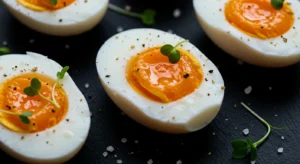Introduction
Jammy Eggs were never just eggs to me. They were the secret in my mom’s morning routine, the quiet joy in a lonely college dorm, and later—the heart of a bowl of ramen I had in a tiny Tokyo alley, where the chef nodded in approval as I cracked the yolk open with my chopsticks. That golden, gooey center? It felt like magic. Not fully cooked, not quite runny—just perfect. There’s something almost emotional about a jammy egg. It’s soft, comforting, and somehow makes even a simple meal feel special. One bite, and you're hooked.
But what makes these little eggs so irresistible? And how do you get them just right every time? That’s exactly what we’re cracking open in this article. We'll start by mastering the basics—how to make jammy eggs with precision and what boil time gives that signature melt-in-the-middle yolk. From there, we’ll explore clever techniques like air frying and Instant Pot shortcuts, as well as deeper questions: Are jammy eggs safe to eat? Can pregnant women enjoy them too? Whether you’re looking to upgrade your ramen, build a protein-packed salad, or just cook a perfect egg that makes you pause mid-bite, every part of this guide will bring you closer to jammy egg mastery.
Each section builds on the last, weaving together tradition, technique, safety, and creativity—all centered around the humble jammy egg. So let’s get started where every journey begins: with the very first perfect peel.
Table of Contents
How to Make Jammy Eggs – Where the Magic Begins
Every jammy egg starts with a little suspense—the kind that builds when you lower a cold egg into boiling water and silently count down. Nailing the perfect texture isn’t guesswork; it’s a ritual. If you’ve ever cracked open a boiled egg only to find it chalky or too runny, you’re not alone. Making jammy eggs that hit that sweet spot—tender whites with golden, creamy yolks—is where the real love for them begins.
Start with fridge-cold eggs and bring a pot of water to a rolling boil. Gently lower the eggs in, then immediately reduce to a gentle simmer. For most medium to large eggs, six and a half minutes is the sweet spot. No more, no less. As soon as the timer rings, plunge the eggs into an ice bath. That cold shock halts the cooking, locks in the yolk texture, and makes peeling smoother than you’d expect. A slight tap, a gentle roll, and the shell slides off like paper.
The beauty of jammy eggs is that they’re simple—but not forgiving. One minute too long and you’ve got a hard-boiled yolk; one minute too short and you’re left with a gooey mess. That’s why our full recipe on how to make jammy eggs breaks down every step, from egg size considerations to water temperature consistency. It’s precision made easy—and once you master it, you’ll never boil eggs the same way again.
Of course, once you know how to make them, the next question naturally follows: how long exactly should you boil them for perfect results, every single time? That’s where we’re headed next in Part “How Long to Boil Jammy Eggs“.
How Long to Boil Jammy Eggs – The Countdown That Matters
Ask any seasoned cook about jammy eggs, and they’ll all say the same thing: it’s all in the timing. Jammy eggs aren’t forgiving when it comes to over- or undercooking. One minute can mean the difference between golden perfection and rubbery regret. That’s why knowing exactly how long to boil them isn’t just helpful—it’s everything.
For medium to large eggs straight from the fridge, the golden number is usually 6 minutes and 30 seconds in simmering water. But even that can change slightly depending on variables: egg size, altitude, and how cold your eggs were to begin with. If you’re boiling more than four at once, a few extra seconds might make all the difference. Consistency is key—use a timer and stick to it like gospel.
Once cooked, they need to go directly into an ice bath. This does two things: it stops the cooking immediately, and it gives the eggs that smooth, easy-to-peel texture. Let them chill for at least five minutes, and you’ll get a yolk that holds its shape but still glistens like golden velvet.
In our complete guide to how long to boil jammy eggs, we break down boiling times by egg size and include tips on testing doneness without slicing into every egg. It’s a science and an art—and once you’ve found your rhythm, you’ll have confidence with every batch.
But what if you could skip the boiling altogether and still get those dreamy centers? In Part “What Is a Jammy Egg“, we’ll explore how to create perfect jammy eggs using an unexpected kitchen star: the air fryer.
What Is a Jammy Egg – More Than Just a Southern Breakfast Hero
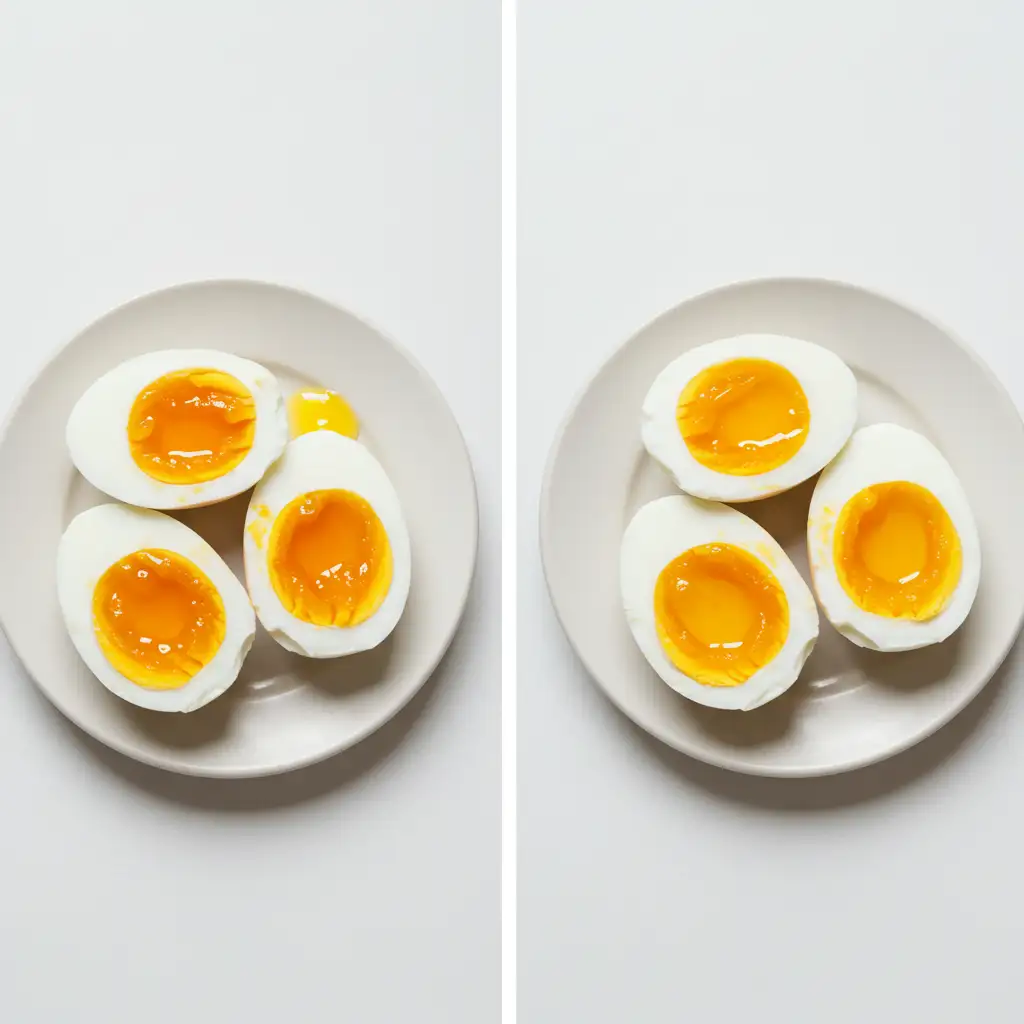
At first glance, a jammy egg might look like any other boiled egg—but cut it open and the difference is obvious. That gooey gold center isn’t just texture; it’s an experience. Southern cooks have been making these perfect yolks for generations, even before the name “jammy egg” found its way into modern kitchens. They simply called them “half-done” or “just right”—a secret staple on breakfast tables across the South.
So what really sets a jammy egg apart? It comes down to precise timing and texture. Unlike soft-boiled eggs, which are often too runny to handle or slice, jammy eggs are firm enough to hold shape but soft enough to melt on your tongue. Their appeal lies in being the perfect middle ground—rich, velvety yolks and tender whites that add warmth to any dish.
In our full guide on what is a jammy egg, we go deep into the origin of the term, how it became popular in digital food culture, and why southern cooks were unintentionally ahead of the trend. It’s not just a culinary term—it’s a technique passed down, refined, and now celebrated worldwide.
And with popularity on the rise, it’s no surprise that jammy eggs have taken over everything from meal prep to restaurant menus. In Part “Jammy Eggs for Ramen“, we’ll explore how ramen became the modern stage where jammy eggs truly shine.
Jammy Eggs for Ramen – The Topping That Steals the Show
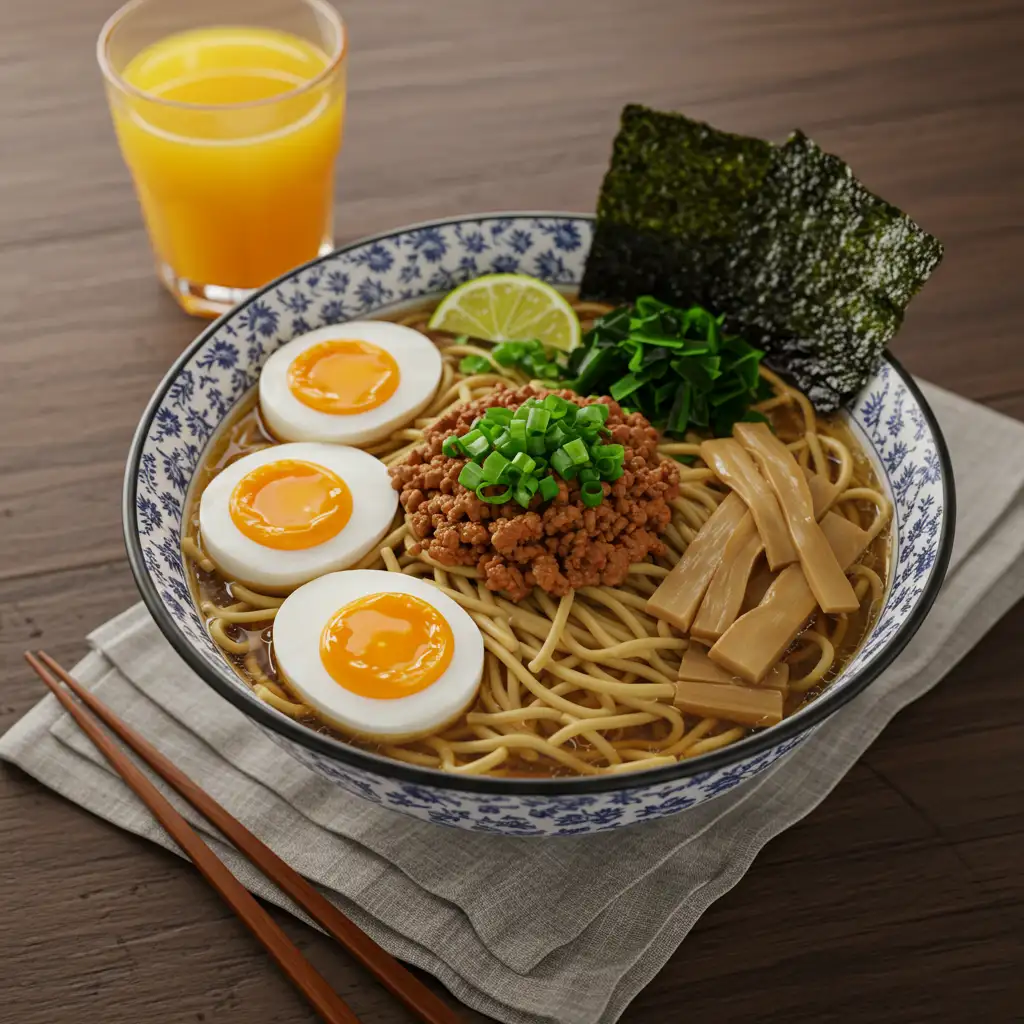
It’s hard to imagine a comforting bowl of ramen without that shining half-egg nestled on top. But not just any egg—a jammy egg, with a rich, soy-marinated center that transforms the dish. These eggs, also known as ajitsuke tamago, may seem humble, but they’re the unsung heroes of the ramen world. And once you taste them in broth, you’ll understand why.
What makes jammy eggs work so well in ramen is all about texture and balance. The slightly firm whites give structure, while the yolk—creamy and golden—melts into the broth, enriching every bite. But it’s not just about boiling. For the full effect, the eggs are cooled, peeled, and then marinated in a savory-sweet soy mixture that infuses them with umami depth.
In our full guide to jammy eggs for ramen, we walk through timing tips, marinade options beyond just soy, and serving ideas that match traditional Japanese techniques with modern creativity. Think miso-infused eggs, spicy garlic blends, or even smoky twists for extra edge.
The real beauty? These eggs don’t just add flavor—they complete the bowl. Unlike other ramen toppings, jammy eggs offer creaminess, protein, and visual appeal all in one bite. Whether you’re crafting a classic tonkotsu or a spicy miso, the jammy egg brings harmony to the chaos.
Next, we shift from pairings to process. In Part “Air Fryer Jammy Eggs“, we’ll take a modern shortcut and see how the air fryer is changing the way jammy eggs are made—without sacrificing that gooey core.
Air Fryer Jammy Eggs – The Smart Shortcut to Gooey Perfection
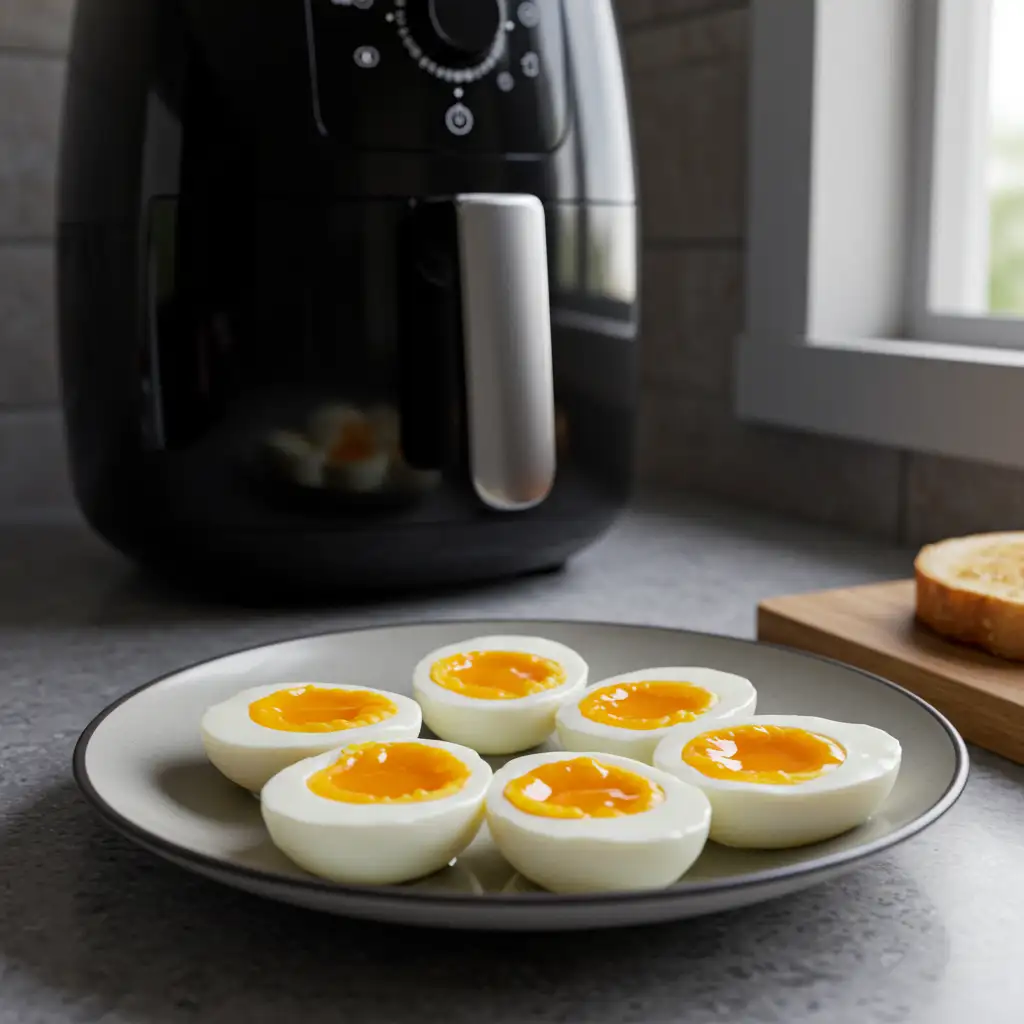
If you’ve ever thought jammy eggs were only for those willing to hover over boiling water with a timer, think again. The air fryer has quietly revolutionized how home cooks prepare jammy eggs, making it easier than ever to achieve perfect results—without a pot or stove in sight.
It’s surprisingly simple. Start with cold eggs from the fridge, place them directly in the air fryer basket, and cook at 270°F (132°C) for about 9 to 10 minutes. Once done, an immediate ice bath is non-negotiable—it halts the cooking and guarantees that signature gooey yolk. The result? A creamy center and tender whites with none of the guesswork.
In our full guide to air fryer jammy eggs, we share timing variations, doneness visual cues, and common troubleshooting tips. From slightly overcooked centers to rubbery whites, the article helps you avoid every pitfall—especially helpful if you’re making these eggs as part of weekly meal prep or for family breakfasts.
One of the best parts? Air fryer jammy eggs are extremely versatile. Slice them over toast, toss them into noodle bowls, or serve alongside roasted veggies for a quick, protein-packed dinner. They’re even safe for pregnancy when properly timed—yes, we cover that too.
Next, we’ll leave the gadgets behind and dive into something classic and comforting: how jammy eggs bring new texture and creaminess to the most nostalgic of dishes—egg salad. Stay tuned for Part Jammy Egg Salad.
Jammy Egg Salad – A Creamy Classic Reinvented
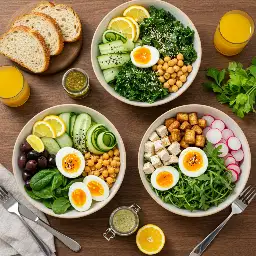
Forget everything you thought you knew about egg salad. When you swap the usual hard-boiled eggs for perfectly cooked jammy eggs, something magical happens. The yolks add an indulgent creaminess, the whites stay tender, and every bite feels richer, smoother, and more satisfying.
This isn’t just about texture—it’s about balance. The soft, jam-like yolks naturally blend with your dressing, making store-bought mayo almost optional. Add a touch of acid (like lemon juice or vinegar), some crunch (hello, celery or pickled onions), and fresh herbs—and you’ve got a flavor-packed bowl that’s good any time of day. Whether it’s served on toast for breakfast or tucked into a lunchbox wrap, jammy egg salad makes protein feel exciting again.
In our complete guide to jammy egg salad, we break down ingredients that pair best, timing tricks for peeling without hassle, and a comparison of cooking methods—from classic boiling to sous vide—to help you choose what works for your routine. You’ll even find creative ideas like Mediterranean blends and Asian-inspired twists that give your salad global flair.
This isn’t just another way to use up eggs—it’s a serious upgrade. And in Part “Instant Pot Jammy Eggs“, we’re exploring another time-saving favorite: the Instant Pot. It turns out, it’s one of the easiest ways to make jammy eggs with zero stress.
Instant Pot Jammy Eggs – Zero Guesswork, All Creaminess
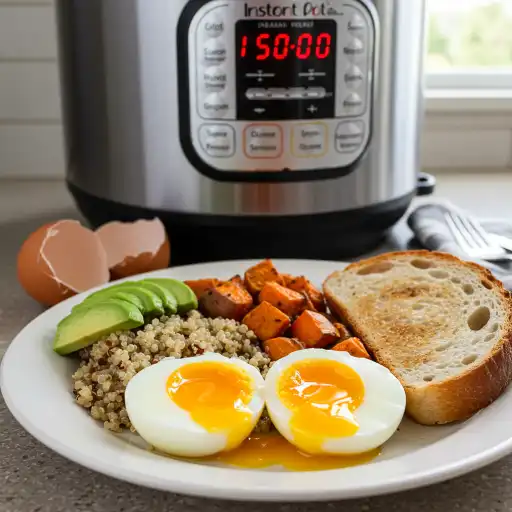
If you’re craving the creamy yolk of a jammy egg but don’t want to stand over a boiling pot, the Instant Pot offers a near-perfect shortcut. The method is precise, foolproof, and ideal for batch cooking, especially if mornings in your kitchen are more chaos than calm.
At the heart of this method is the 5-4-1 rule: 5 minutes under pressure, 4 minutes of natural release, and 1 minute in an ice bath. Some prefer the 5-5-5 method, which adds more control based on egg size and yolk preference. Whichever route you choose, you’ll get consistent results: firm whites and beautifully jammy centers every time.
Our full recipe for Instant Pot jammy eggs offers a full step-by-step walkthrough, equipment list, storage tips, and smart reheating instructions so you never overcook those golden yolks. Whether you’re topping a ramen bowl, building a grain bowl, or layering toast with something special, this method makes it easy to prep multiple eggs at once.
And yes—it’s safe. With precise timing and quick chilling, these eggs are not only delicious but suitable for meal preppers, families, and even picky eaters. They peel easily, last in the fridge for days, and hold up beautifully when pickled or reheated.
Now that we’ve mastered efficiency, it’s time to go gourmet. In Part “Sous Vide Jammy Eggs“, we’ll explore the most precise cooking technique of them all—sous vide—for those who want absolute perfection, every single time.
Sous Vide Jammy Eggs – Precision Cooking at Its Best

For those who love perfection down to the second, sous vide jammy eggs deliver unmatched consistency. With exact temperature control, there’s no guessing, no overcooking, and no dry yolks. Just smooth, silky centers and fully set whites—every single time.
Sous vide works by cooking eggs gently in a water bath set to a precise temperature—typically between 145°F to 147°F. After about 45 minutes, the result is yolks that are thick and jam-like, with texture you just can’t get from boiling or steaming. If you want more control over how soft or firm the yolk is, all it takes is adjusting time or temperature slightly. We break it all down in our full guide to sous vide jammy eggs, including a handy timing chart for every yolk preference.
This method isn’t just for chefs—it’s a dream for home cooks who meal prep. These eggs hold their shape beautifully, peel easily, and are incredibly versatile. Add them to bowls, salads, or toast—or just eat them chilled with a sprinkle of flaky salt. The possibilities are endless, especially when you begin experimenting with herbs, sauces, or infused oils.
Wondering about safety? Sous vide is not only food-safe, but the gentle cooking ensures pasteurization when done correctly—making it safe even for pregnancy when handled and stored properly. And we walk you through all that too.
So if you’ve ever wished for jammy eggs that never miss, sous vide might just be your new favorite method. Next up in Part “Are Jammy Eggs Safe to Eat?“, we’ll take a closer look at a question many home cooks ask: are jammy eggs really safe to eat?
Are Jammy Eggs Safe to Eat? – Cracking the Myths and Truths
One of the most common questions home cooks ask when it comes to jammy eggs is simple but important: are they actually safe to eat? The yolk isn’t fully firm, the center is soft—so does that mean it’s risky? The short answer: not if you’re doing it right.
Safety with jammy eggs comes down to one key factor—temperature. If the egg reaches an internal temperature of at least 160°F, harmful bacteria like salmonella are destroyed. That’s why timing and cooking method matter. In our complete guide on whether jammy eggs are safe to eat, we walk through how to achieve that safe zone whether you’re boiling, steaming, or using sous vide.
Worried about salmonella? It’s a valid concern, but pasteurized eggs greatly reduce the risk. Even better, proper handling—like using fresh eggs, refrigerating them promptly, and avoiding cracked shells—adds another layer of protection. We also tackle concerns that surface during headlines like “bird flu season” or egg recalls, offering level-headed tips rooted in science, not fear.
The truth is, jammy eggs are enjoyed every day in homes and restaurants across the world. Southern kitchens, in particular, have served versions of these eggs for decades—long before the term “jammy” became trendy. The key lies in knowing your source, cooking with care, and storing smart.
And yes, when prepared correctly, they’re even safe during pregnancy. In Part “10“ Can Pregnant Women Eat Jammy Eggs?“, we’ll talk specifically about that—because sometimes craving a jammy yolk is more than a preference, it’s a need.
Can Pregnant Women Eat Jammy Eggs? – Safety, Cravings, and Confidence
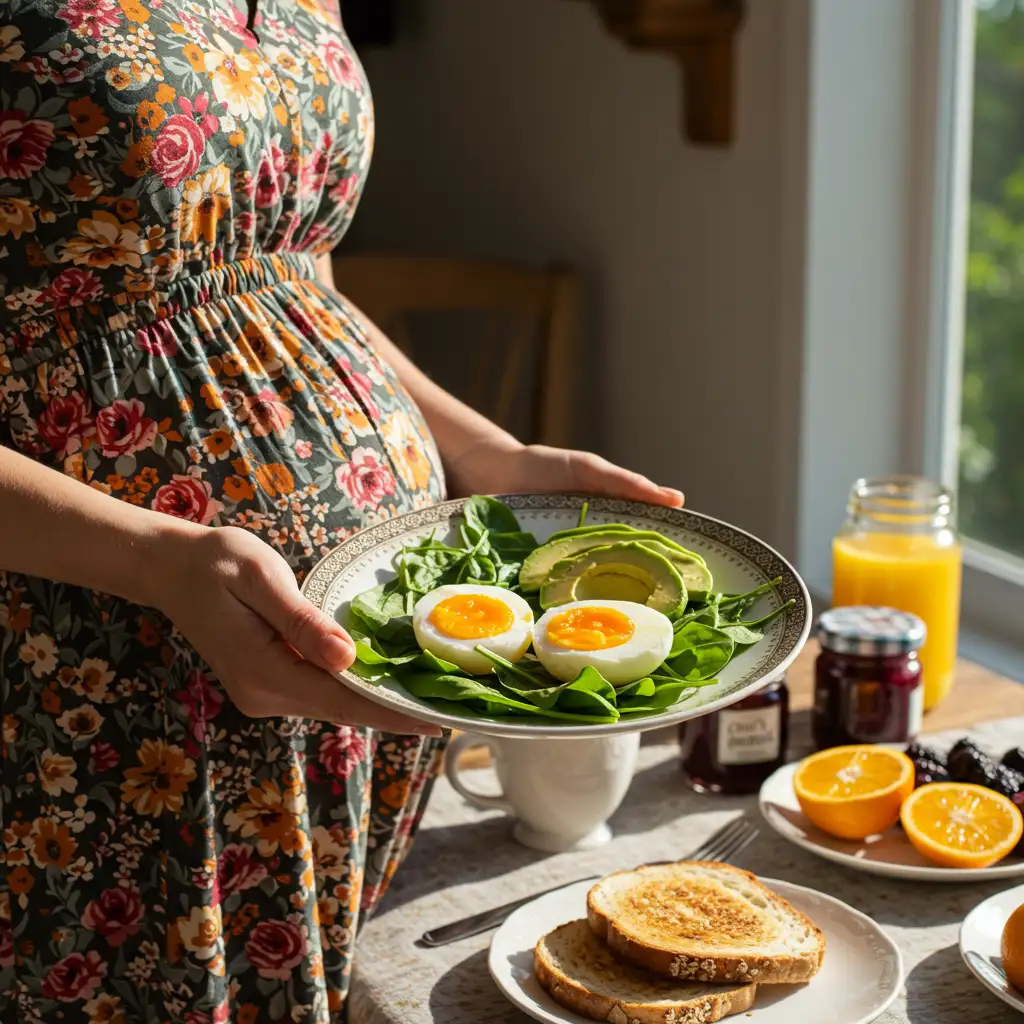
Pregnancy changes everything—including how you look at your favorite foods. If you’re wondering whether you can still enjoy those soft, golden jammy eggs, the answer isn’t just a yes—it’s a qualified yes, when done safely.
The key lies in how you cook them. As long as the egg is cooked to an internal temperature of 160°F and properly handled afterward, it’s considered safe even during pregnancy. That’s why methods like sous vide (with pasteurized eggs), air frying, and Instant Pot cooking—when combined with an ice bath—are ideal. They offer the right balance of safety and softness. In our full article on whether pregnant women can eat jammy eggs, we go deep into safe preparation techniques and which types of eggs to avoid—like unpasteurized or undercooked farm eggs.
But it’s not just about risk—it’s about benefits, too. Jammy eggs are packed with protein, choline, and healthy fats, all essential for fetal development. Many women find themselves craving soft yolks during pregnancy because their bodies are asking for precisely what jammy eggs offer.
You’ll also find safe and delicious pairings in the article—like pairing jammy eggs with whole grains, leafy greens, and creamy avocado for nutrient-rich meals. Whether it’s once a week or more, they can be part of a healthy pregnancy plan when prepared with care.
So go ahead, enjoy that bold, soft yolk. It’s not only possible—it’s smart, satisfying, and absolutely safe when done right.
Frequently Asked Questions (FAQs)
1. How do you make jammy eggs at home without overcooking them?
The key is precision. Boil cold eggs for exactly 6 minutes and 30 seconds, then transfer them immediately to an ice bath. Timing and temperature control are everything. You can also try the Instant Pot or sous vide for consistent results.
2. What does “jammy” mean in jammy eggs?
“Jammy” refers to the texture of the yolk—it’s thick, glossy, and spreads like soft jam. It’s not runny like soft-boiled, nor crumbly like hard-boiled. It’s that irresistible in-between.
3. What makes jammy eggs different from soft-boiled eggs?
While both have soft yolks, jammy eggs are slightly more set. The yolk is creamy and holds its shape, whereas soft-boiled yolks tend to run. Jammy eggs are easier to peel, plate, and use in meals.
4. Can you eat jammy eggs cold?
Yes! Jammy eggs are delicious cold—great for meal prep, salads, and quick snacks. Just store them properly in the fridge and consume within 3–4 days.
5. Are jammy eggs safe during pregnancy?
Yes, if prepared correctly. Use pasteurized eggs and ensure they’re cooked to at least 160°F internally. Instant Pot and sous vide methods are excellent for reliable, pregnancy-safe yolks.
6. How long do jammy eggs last in the fridge?
Stored in an airtight container, they’ll stay fresh for up to 4 days. Keep them chilled and avoid leaving them at room temperature for too long.
7. What’s the best method for peeling jammy eggs cleanly?
Shock them in an ice bath for at least 5 minutes. Then gently crack and roll them on a hard surface before peeling under running water. Fresh eggs are harder to peel—use eggs that are 5–7 days old for best results.
8. Can jammy eggs be reheated?
They can, but gently. Place them in warm (not boiling) water for 1–2 minutes. Avoid microwaving—they’ll overcook and dry out the yolk.
9. Are there vegetarian or vegan alternatives to jammy eggs?
While nothing truly mimics the yolk texture, some chefs use tofu and plant-based marinades to create similar richness in flavor and look. However, it’s more fusion than replacement.
10. Why do jammy eggs go so well with ramen?
The yolk adds richness to the broth, while the marinated whites bring umami depth. It balances salty, spicy, and savory flavors and makes the dish more filling and satisfying.
Conclusion: A Golden Center to Remember
There’s something quietly magical about a jammy egg. Maybe it’s the soft resistance of the white giving way to a warm, golden center. Maybe it’s the way it completes a bowl of ramen, lifts a humble salad, or turns toast into a moment worth savoring. But more than texture or taste, jammy eggs have a kind of presence—small, unassuming, and yet unforgettable.
In this journey, we cracked the code of jammy perfection. We boiled, peeled, marinated, and plated. We air-fried and pressure-cooked. We questioned safety, debunked myths, and even explored pregnancy cravings. But at the heart of it all was one simple truth: a jammy egg isn’t just food—it’s comfort, creativity, and quiet confidence in every bite.
From southern kitchens to Tokyo noodle bars, from meal-prepping moms to curious home cooks, jammy eggs have found their way into countless lives. And now, into yours. Whether you choose to make them with precision sous vide or toss them into a grain bowl with abandon, they’re yours to reimagine, to perfect, and—above all—to enjoy.
So the next time you slice into that soft yolk and it glows back at you like golden sunlight, pause. Smile. You’ve just made something simple… unforgettable.
Love jammy eggs as much as we do?
Join our Facebook page for more egg hacks and quick breakfast ideas:
👉 https://www.facebook.com/astrorecipes1






